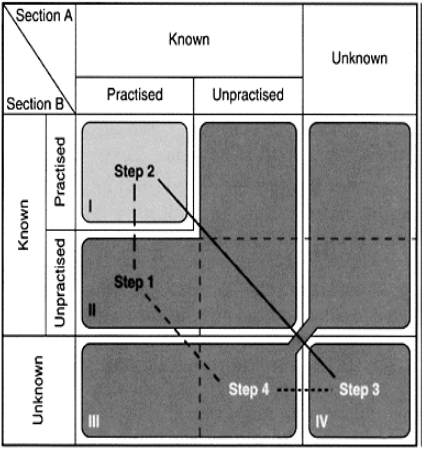Joharry’s New Window On Standardization And Causes Of Quality Failures
Introduction:
Classification and the cause of the failures are shown with the help of Joharry’s ‘new window’. A manufacturing company in Japan developed this diagram.
Conclusions about the windows:
1. Standardization is the basis of continuous improvements.
2. Standardization only is not sufficient. It may take a while before the standard methods for control and prevention of defects are in fact practised by everybody they concern.
3. Communication and motivation is the basis for everybody to practise the standardized methods and is also the basis for everybody trying continuously to improve existing standards.
4. There is no reason to try to find better methods before the existing know-how is being used by everybody it concerns.
Joharry’s window consists of four small windows:
1. The first ‘window’ (category I) refers to what both you and I know.
2. The second ‘window’ (category II) refers to what I know and you do not know.
3. The third ‘window’ (category III) refers to what you know and I do not know.
4. The fourth ‘window’ (category IV) refers to that which neither knows

Fig: Joharry’s window
Explanation of the window by FUKUDA:
The following explanation of the model is given by Fukuda (1983);
1.The different categories represent interrelationship of the counterparts Section A and Section B. These terms can be used to refer to individuals, groups, teams, sections within the organization etc.
2.In the ‘known-practised’ column, the respective party already knows the right methods to prevent defects and also executes them correctly.
3.Inthe ‘known-unpracticed’ column, the respective party knows the right methods but executes them insufficiently or not at all.
4.In the ‘unknown’ column, the respective party does not yet know the right methods to prevent defects.
5.In category I, everyone in both parties knows and correctly practices the best and most effective operation known at any given time. All standard operations must be included
in this category.
6.In category II, everyone in both parties is informed of the standard operations but there is someone who does not practise them correctly. This includes the case where someone fails to adhere to standard operations out of carelessness.
7.In category III, one party knows but the other party does not know the right operations for preventing defects.
8.In category IV, no one in either party knows the right techniques yet. The technical problems which cause defects remain unsolved in this category.

Fig: Joharry’s ‘new window’